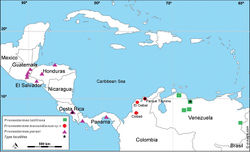Proneotermes latifrons
| Notice: | This page is derived from the original publication listed below, whose author(s) should always be credited. Further contributors may edit and improve the content of this page and, consequently, need to be credited as well (see page history). Any assessment of factual correctness requires a careful review of the original article as well as of subsequent contributions.
If you are uncertain whether your planned contribution is correct or not, we suggest that you use the associated discussion page instead of editing the page directly. This page should be cited as follows (rationale):
Citation formats to copy and paste
BibTeX: @article{Casalla2016ZooKeys, RIS/ Endnote: TY - JOUR Wikipedia/ Citizendium: <ref name="Casalla2016ZooKeys">{{Citation See also the citation download page at the journal. |
Ordo: Isoptera
Familia: Kalotermitidae
Genus: Proneotermes
Name
Proneotermes latifrons (Silvestri, 1901) – Wikispecies link – Pensoft Profile
Material examined
Venezuela: Bolivar State, El Pauji: 4.4675°N, 61.5947°W, 600m, 25.VII.2003, J Perozo, University of Florida no. SA336: 2 soldiers and pseudergates. Falcon State, La Chapa: 11.2657°N, 69.6022°W, 703m, 27.V.2008, Scheffrahn et al., VZ833, 2 soldiers, pseudergates. Lara State, Copeyal: 10.4409°N, 69.4402°W, 590m, 28.V.2008, Scheffrahn et al., VZ1014, 10 soldiers, pseudergates. Yaracuy State, Licua: 10.3377°N, 69.1344°W, 650m, 30.V.2008, Scheffrahn et al., VZ1180-11183, 4 colonies, many soldiers, pseudergates.
Soldier
(Fig. 4D–F, Table 6). Head in dorsal view with frons dark glossy until faint bridge, grading from ferruginous orange to orange-yellow toward vertex. Postclypeus whitish at borders. Mandibles black anteriorly and reddish brown at hump. Head in lateral view with dark ferruginous orange, then turns orange to genal region. Head in ventral view with postmentum chestnut-dark brown and whitish at anterior border and genal margin pale orange. Eye spots distinct, unpigmented. Pronotum hyaline with sclerotized borders. First three antennal segments darker.
| No. | Measurements in mm (n = 11). | Mean | SD | Range |
|---|---|---|---|---|
| 1 | Head length to tip of mandibles | 2.96 | 0.19 | 2.65–3.35 |
| 2 | Head length to frontal horns | 1.82 | 0.31 | 1.10–2.25 |
| 3 | Frontal flange width | 1.06 | 0.12 | 0.90–1.25 |
| 4 | Genal horns, outside span | 1.33 | 0.12 | 1.20–1.55 |
| 5 | Head width max. | 1.46 | 0.12 | 1.15–1.60 |
| 6 | Head height excluding postmentum | 1.17 | 0.14 | 1.00–1.50 |
| 7 | Pronotum max. width | 1.49 | 0.12 | 1.20–1.65 |
| 8 | Pronotum max. length | 0.82 | 0.09 | 0.70–0.95 |
| 9 | Left mandible length, tip to ventral condyle | 1.06 | 0.03 | 1.00–1.10 |
| 10 | Total length | 7.38 | 0.61 | 6.80–8.80 |
| 11 | No. antennal articulations | 11 | 0.7 | 10–12 |
Comparisons
Soldiers of Proneotermes latifrons are separated from congeners in having a wide and darker convex frons with narrow undulations dorso-laterally. Postclypeus whitish at border, labrum wider than long and darker postmentum. Proneotermes latifrons is distributed in Venezuela, while Proneotermes perezi is widely distributed in Central America, from Guatemala to Panama (Fig. 1).
Taxon Treatment
- Casalla, R; Scheffrahn, R; Korb, J; 2016: Proneotermes macondianus, a new drywood termite from Colombia and expanded distribution of Proneotermes in the Neotropics (Isoptera, Kalotermitidae) ZooKeys, (623): 43-60. doi
Images
|

